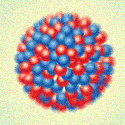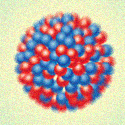Calculations for complex nuclei
Finding reliable computational tools for understanding the behavior of complex nuclei remains one of the central issues in theoretical nuclear physics. The traditional approaches to this problem are based on effective or approximate many-body theories. These approaches suffer from the lack of analytical techniques for solving for the complicated many-body interactions known to be present among nucleons. Direct numerical simulations of nuclei are a potential alternative to analytical methods. However, brute force methods for simulating nuclei are likely to fail without additional inputs from other theoretical approaches due to the enormous computational complexity of the problem.
Writing in Physical Review Letters, Evgeny Epelbaum, Hermann Krebs, Dean Lee, and Ulf Meißner, in a collaboration involving institutions in Germany and the US, combine analytical and numerical approaches to compute the binding energies of nuclei as large as carbon- . Epelbaum et al. use an analytic scheme for formulating the effective many-body dynamics that systematically accounts for nuclear interactions of increasing complexity up to next-to-next-to-leading order and also incorporates isospin breaking and Coulomb effects. Furthermore, they are able to simulate the effective dynamical models numerically to predict various measurable quantities for complex nuclei. The computational scaling of this method suggests applications to even larger nuclei in the future. – Abhishek Agarwal





